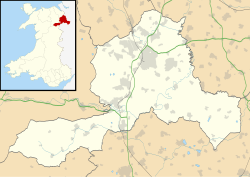Pen-y-cae
| |
|---|---|
 Zion English Baptist Church, Pen-y-cae | |
Location within Wrexham | |
| Population | 3,389 (2011) |
| OS grid reference | SJ279452 |
| Community |
|
| Principal area | |
| Country | Wales |
| Sovereign state | United Kingdom |
| Post town | WREXHAM |
| Postcode district | LL14 |
| Dialling code | 01978 |
| Police | North Wales |
| Fire | North Wales |
| Ambulance | Welsh |
| UK Parliament | |
| Senedd Cymru – Welsh Parliament | |

Pen-y-cae (sometimes spelled Penycae) is a village and community in Wrexham County Borough, Wales. The population of the community taken at the 2011 census was 3,389. [1] It adjoins the larger village of Rhosllanerchrugog.




